
-
Gate with two passages. Wrought iron. Spain, 17th century. Window grille made of wrought iron with two smooth circular cross-sections in the middle, inserted between the vertical bars. These have a decoration of small discs and balustrade shapes (which add a slight movement) between both cross-sections, facing the compositions to create harmony. The decorative details mentioned refer to 17th century Baroque works in this material: compare, for example, with the balconies of the Casa de Panadería in the Plaza Mayor in Madrid, or with Spanish pieces preserved in the Victoria and Albert Museum in London, a confessional grille in the Metropolitan Museum in New York dated 1629 (inv. 57.137.51) and another from the same museum made by the master Francisco González (inv. 56-234.12Ad).
· Size: 120x38x133 cms.
ANTIQUES
MISCELLANEUS;OTHER OBJECTS
Ref.: Z5602
-
Box in enamelled porcelain and engraved glass. 19th century. Oval box with a base made of etched glass and a hinged lid, the latter made by combining enamel and metal. The lower part presents a bucolic landscape, with a series of human figures and buildings in it, combining trees with lakes and solid ground. The scene on the upper part responds to the same typology: a couple in an idealized rural landscape.
· Size: 7,5x6x4,5 cms.
ANTIQUES
MISCELLANEUS;OTHER OBJECTS
Ref.: Z6447
-
Toiletry bag. 19th century. Tortoiseshell, metal, glass. Rectangular case with a hinged lid made of tortoiseshell decorated with fine inlaid plant and floral elements on its sides, containing a toiletry bag set composed of various feminine toiletries and personal items (a small perfume bottle, scissors, a thimble, etc.), with a space designed for each of these utensils.
· Size: 6x3x8 cms.
ANTIQUES
MISCELLANEUS;OTHER OBJECTS
Ref.: Z6854
-
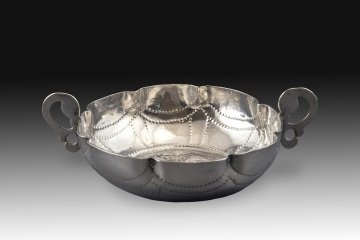
Catavinos or quaking glass. Silver. 18th century. Without contrast marks. Vessel known as catavinos or tembladera with two flat, closed “S” shaped handles and a line of “bites” (gallon-shaped shapes) highlighted by bands of dots that move to the inside of the piece. The bottom has a star shape (leaving smooth and with a shiny finish some stripes forming a Maltese Cross, and combining in the rest areas in the same finish with others in diamond-shaped lustre with dots). The bernegales and tembladeras with mortise-shaped pieces were frequent pieces in Spanish silverwork in the 17th century, usually being relegated to centres of somewhat less importance in the 18th century. Compare this with pieces such as the silver bernegal from the last third of the 17th century in the Lázaro Galdiano Museum (perhaps from the Portuguese school; inventory 3916), or the one dated between 1640 and 1665 from the same museum (inventory 3910), or the one by José Jiménez de Illescas (inventory 3915, dated 1715-1725) in the same institution. Weight: 83 gr.
· Size: 14,5x11x3 cms.
ANTIQUES
MISCELLANEUS;SILVER
Ref.: ZE192
-
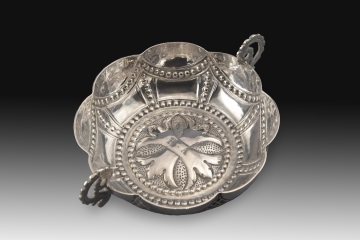
Catavinos or quaking glass. Silver. 18th century. Without hallmarks. With ownership initials. Vessel known as a catavinos or tembladera with two curved flat handles decorated with simplified plant elements, and a line of morsels (gallon-shaped shapes) on the edge enhanced by bands of sunken dots that remain in relief on the inside of the piece, where they extend and frame the decoration on the bottom. In this area there is a florentine Greek cross in a smooth shiny finish with the letters “RA” engraved (initials of the property), highlighted on a dotted background. The bernegales and tembladeras with mortise-shaped pieces were frequent pieces in Spanish silverwork in the 17th century, usually being relegated to centres of somewhat less importance in the 18th century. Compare this with pieces such as the silver bernegal from the last third of the 17th century in the Lázaro Galdiano Museum (perhaps from the Portuguese school; inventory 3916), or the one dated between 1640 and 1665 from the same museum (inventory 3910), or the one by José Jiménez de Illescas (inventory 3915, dated 1715-1725) in the same institution. Weight: 94 gr.
· Size: 13,5x10,5x4,5 cms
ANTIQUES
MISCELLANEUS;SILVER
Ref.: ZE193
-
Catavinos or quaking glass. Silver. 17th century. Without contrast marks. Vessel known as a catavinos or tembladera with two flat, closed “S”-shaped handles (with simplified plant decoration) and a line of “bites” (gallon-shaped shapes) highlighted with bands of dots. On the bottom, inside, there is an eight-petaled flower engraved with a cross inside. The bernegales and tembladeras with mortise-shaped pieces were frequent pieces in Spanish silverwork in the 17th century, usually being relegated to centres of somewhat less importance in the 18th century. Compare this with pieces such as the silver bernegal from the last third of the 17th century in the Lázaro Galdiano Museum (perhaps from the Portuguese school; inventory 3916), or the one dated between 1640 and 1665 from the same museum (inventory 3910), or the one by José Jiménez de Illescas (inventory 3915, dated 1715-1725) in the same institution. Weight: 96 gr.
· Size: 15x10,5x4,5 cms.
ANTIQUES
MISCELLANEUS;SILVER
Ref.: ZE195
-
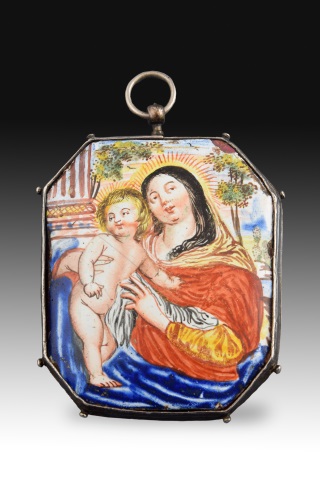
Reliquary pendant. Silver, enamel, textile. 17th century. A large polygonal pendant with a silver frame in its colour decorated with small pearls of the same material located in the corners of the edge, which has a ring at the top so that it can be hung or carried. One of its fronts has a textile background under a sheet of transparent glass, probably designed to contain relics. The other has a brightly coloured enamel showing the Virgin Mary in three-quarters, with the naked Child Jesus in her arms and both figures cut out against a landscape background with classicist architectural elements (a column with a fluted shaft on a pedestal, with mouldings) and details of a natural landscape (thus linking the moment with the Rest on the Flight into Egypt; compare, also, with works such as the Virgin and Child by Anton van Dyck from the Cerralbo Museum in Madrid or the oil painting from The Walters Art Museum, or the engraving by Paulus Pontius following Van Dyck's models - where the elements coincide in arrangement with those of the medallion -, for example). This type of jewellery has always had great value, both for the materials used and for its religious content. Despite this (or perhaps because of this same appreciation) there are not many examples of quality and in good condition, and it is possible to find them only in important private collections and in outstanding museums such as the Fundación Valencia de Don Juan in Madrid, the Museo Nacional de Artes Decorativas in the same city, etc., or old religious centres such as the Convent of the Descalzas Reales in Madrid.
· Size: 6,5x0.5x8 cms.
ANTIQUES
MISCELLANEUS;JEWELRY
Ref.: ZF0399
-
Mortar. Carved stone. 18th century. Mortar made from a single piece of carved stone with a circular base and four handles or worn projections carved towards the outside of its body, in the shape of a cup. This type of piece was created for use in apothecaries (which could be in a city, in a religious institution or in a hospital) or in a kitchen (of a large residence or, again, of a religious institution), and it is not possible to specify its purpose further due to the lack of decorative elements and the usualness of the model to which this piece belongs, with a long tradition in Europe. Similar examples are preserved, for example, in the Museum of the Spanish Pharmacy of the Complutense University of Madrid, the Museum of the History of Pharmacy in Seville, the Museum of Pharmacy in Krakow, etc.
· Size: 73x73x45 cms.
ANTIQUES
MISCELLANEUS;MORTARS
Ref.: Z1057
-
Special Offer! - Off
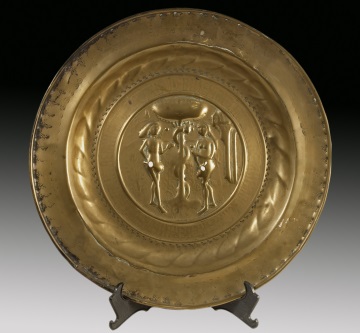
Alms plate. Nuremberg, 16th century. Alms plate made of gilded brass, decorated with a series of moldings and details both on the rim and towards the center. In this area is a figurative motif in slight relief (Adam and Eve flanking the tree around which the Serpent of Original Sin is coiled).
· Size: 38x38x5 cms.
ANTIQUES
MISCELLANEUS;OTHER OBJECTS
Ref.: Z5163
-
Special Offer! - Off
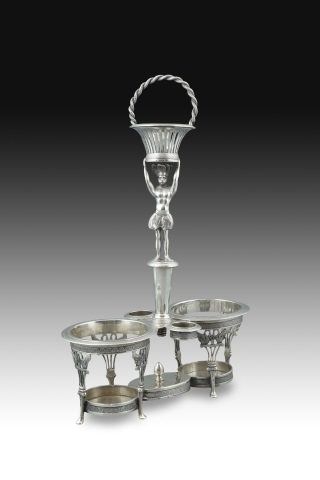
Convoy of silver vinegar cruets, Santander, 19th century. With hallmarks, local and silversmith's marks (Santander, Trabanco, M.Navarro). Holding a basket with a handle on his head is the figure of an Indigenous man, wearing a skirt and a feathered headdress. The figure stands atop a column, flanked by two circular spaces for oil and vinegar cruets and two other supports for salt and pepper shakers. The decoration, featuring columns and classical palmettes, is characteristic of Neoclassicism, while the presence of the feathered Indigenous man adds a touch of exoticism highly valued in the 19th century. Weight 950 gr.
· Size: 22x9x34 cms.
ANTIQUES
MISCELLANEUS;SILVER
Ref.: Z6231
-
Pair of wrought iron fork locks. 17th century. Pair of forged iron fasteners of the so-called “fork” type due to their shape. This type of piece was used in furniture to secure tables, both dining tables and desks, and for this reason it is a very common piece of forged iron. The spirals and the balustrade parts date both to the Baroque period.
· Size: 22x6x78 cms
ANTIQUES
MISCELLANEUS;OTHER OBJECTS
Ref.: Z5019
-
Special Offer! - Off
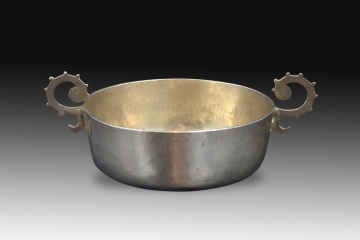
Bernegal, 18th century. Silver, with marks. Weight: 55 g. Spanish Bernegal from the 18th century, marked Vidal, with a wide, low bowl, slightly rounded towards the base, following the typical style of this vessel in the Spanish Baroque period. Also characteristic of this style are the two vertical handles above the rim, in this case in the form of a mitered "S"-shaped bracket with a cut-out profile and small tendrils.
· Size: 4x10,5x7,2 cms.
ANTIQUES
MISCELLANEUS;SILVER
Ref.: Z5724
-
Pastoral box. Carved horn, wood, metal. Spanish school, 1861. Submits registrations. Oval box made of antler carved in its colour, with wood on the lid to reinforce it, decorated on the outside with a series of engraved elements. On the base there is an animal or monster, on the lid there is a monstrance or ostensorium with a cross in the centre and a large base with geometric elements, surrounded by angular shapes acting as a frame. Under the antler hinge there is the date of the piece's creation (1861) and, between two bands of angular elements, an inscription (I am from francys / inverted d / a rhombus / poios), alluding to the owner (and possibly the craftsman) of the work. These types of boxes, of popular tradition, were common in ancient times and were usually made by shepherds or cattle breeders themselves to store snuff or tobacco.
· Size: 7x4x4 cms.
ANTIQUES
MISCELLANEUS;OTHER OBJECTS
Ref.: ZE351A
-
Box. Wood, mother-of-pearl. 19th century. Rectangular box with lid made of dark wood and decorated with lines and plant elements, small furniture items, animals, etc. in marquetry mother-of-pearl applications, with engraved or inked details. This type of piece was highly appreciated in Europe, coming from workshops in China or Vietnam.
· Size: 22,5x15x11 cms.
ANTIQUES
MISCELLANEUS;OTHER OBJECTS
Ref.: ZE358
-
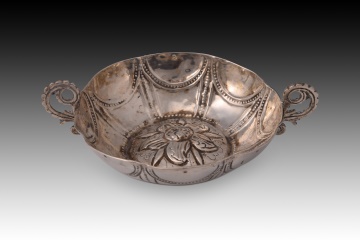
Catavinos or quaking glass. Silver. 18th century. Vessel known as a catavinos or tembladera (as it has no foot) made of silver in its colour with two curved flat handles decorated with simplified plant elements, and a line of mortise (gallon-shaped shapes) on the edge enhanced by bands of sunken dots that remain in relief on the inside of the piece, where they extend and frame the decoration on the bottom. In this area there is a flower, enhanced with a line of dots. Bernegales and mortise-shaped bernegales were frequent pieces in Spanish silverware in the 17th century, usually being relegated to centres of somewhat less importance in the 18th century. Compare with pieces such as the silver bernegal from the last third of the 17th century in the Lázaro Galdiano Museum (perhaps from the Portuguese school; inventory 3916), or the one dated between 1640 and 1665 from the same museum (inventory 3910), or the one by José Jiménez de Illescas (inventory 3915, dated 1715-1725) in the same institution. Weight: 79 grams.
· Size: 15x11x4 cms.
ANTIQUES
MISCELLANEUS;SILVER
Ref.: ZE366
-
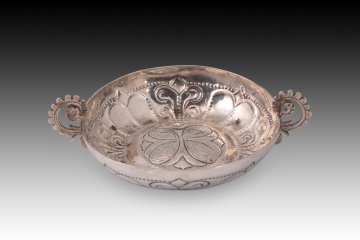
Quaking glass or wine-tasting glass. Silver. 18th century. Vessel known as a catavinos or tembladera (as it has no foot) made of silver in its colour with two flat handles in the shape of a “C” topped by volutes and decorated with wavy elements on the outside, which has a decoration on the edge (on the outside) of simple plant elements alternating with simple geometric elements made with lines and dots. On the bottom, on the inside, there is a plant element. In Spanish silverwork, the Baroque trends were maintained for almost the first two thirds of the 18th century, except in the capital, where Rococo forms were already introduced without displacing the previous ones. It was not until 1740 when French silversmiths introduced these novelties in Madrid, which would slowly spread to the rest of the centres, depending on the areas and masters. This survival of the forms of the 17th century can be seen in the fact that bernegales tembladeras were, in general, more common pieces in the 17th century, remaining during the 18th century relegated to centres far from the main areas of creation. Weight: 91 grams.
· Size: 14,5x11x3,5 cms
ANTIQUES
MISCELLANEUS;SILVER
Ref.: ZE368
-
Mortar and pestle. Bronze. 15th century. Bronze mortar and pestle with a circular base and a spouted mouth decorated with a band beneath the rim. The base, facing outward, features three smooth lines in relief, above which appears a decoration framed by a band at the top consisting of heavily worn elements or masks over Gothic-style calligraphy. Reminiscent of French pieces held in private collections. Weight: 2.8 kg.
· Size: 13x13x9.5 cms
ANTIQUES
MISCELLANEUS;MORTARS
Ref.: ZF1401
-
Sold
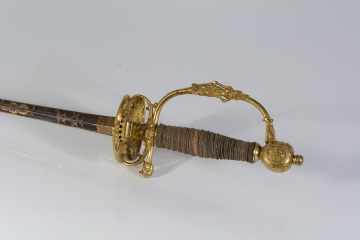
"
· Size: Long. 97 cms.
ANTIQUES
MISCELLANEUS;OTHER OBJECTS
Ref.: Z5912
-
Special Offer! - Off
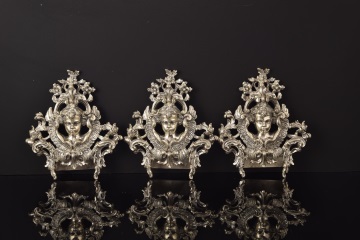
Three finials for a cross. Silver in its natural color. 20th century, following 18th-century models. Each of the three pieces features, as its central motif, a winged angel's head, surrounded and enhanced by an elaborate composition of architectural and vegetal elements, both strongly influenced by classical art. They are made of silver in its natural color and bear no hallmarks. Stylistically, they are inspired by 18th-century Spanish models. Weight: 780 grams.
· Size: 10,5x3x12 cmsm (sujección 5x2 cms)
ANTIQUES
MISCELLANEUS;SILVER
Ref.: Z6590
-
Pocket watch, Frères Esquivillon & De Choudens (ca. 1765-1830). Paris, France, 19th century. Pocket watch of the saboneta type with the exterior decorated in enamels (architectural composition with a certain exotic air) and white dial with Roman numerals for the hours and Arabic numerals every five for the minutes, and an inscription relating to its origin (which is referred to a series of engravings on machinery). “Frères Esquivillon & De Choudens” worked in Paris between about 1765 and 1830, creating highly valued pieces currently preserved in numerous private collections and in institutions such as the Metropolitan Museum in New York.
· Size: 6x1x6 cms.
ANTIQUES
MISCELLANEUS;CLOCKS
Ref.: Z2298
-
Case with campaign cutlery and pocket knife. 19th century. A cylindrical case with a hinged closure that contains various field cutlery, such as a spoon, a knife, a removable fork, etc. secured in a rigid case and stored in a metal container. This type of travel item was widely used during the 19th century.
· Size: 8x8x16 cms.
ANTIQUES
MISCELLANEUS;OTHER OBJECTS
Ref.: Z3806
-
Pair of frames. Wood. 20th century. Pair of carved wooden frames decorated on the front with a composition of mouldings of different widths, all smooth, combining straight and curved shapes.
· Size: 152x7x172 cms.
ANTIQUES
MISCELLANEUS;FRAMES
Ref.: Z3959
-
Silver Bernegal. Portugal, 19th century. With contrasting marks on the base. Bernegal with wavy edges, rocaille decoration and plant elements on the outside and two “S” shaped handles. The flower that decorates the base on which this vessel rests can be found with the hallmarks, which date and situate the work in Portugal, in the 19th century, a time when it was very common to be inspired by styles of the past (Baroque, in this case). Weight: 170 gr.
· Size: 18,5x15x7 cms.
ANTIQUES
MISCELLANEUS;SILVER
Ref.: Z4961
-
Photograph and signature. Vaslav Niyinsky (kyiv, 1890-London, 1950), 1914. Vaslav Niyinsky (transliterated Vátslav Fomich Nizhinski) was a Polish-born Russian ballet dancer and choreographer, considered one of the most gifted in history, notable above all for his meeting with Sergei Diaghilev, a member of the St. Petersburg elite and an important patron of the arts, who promoted Russian visual and musical art abroad, particularly in Paris. During the First World War, Nijinsky was placed under house arrest in Hungary for being a Russian citizen. Diaghilev managed to get Nijinsky out of the country thanks to the intervention of Alfonso XIII and his Oficina Pro Cautivos (Office for the Protection of Prisoners). The signature is accompanied by a photograph of the employees, which were used as business cards at the time (cabinet photograph), and is dated 1914.
· Size: 58x6,5x49 cms. int: 40,5x31 cms.
ANTIQUES
MISCELLANEUS;GRAPHIC WORK
Ref.: ZF1340B